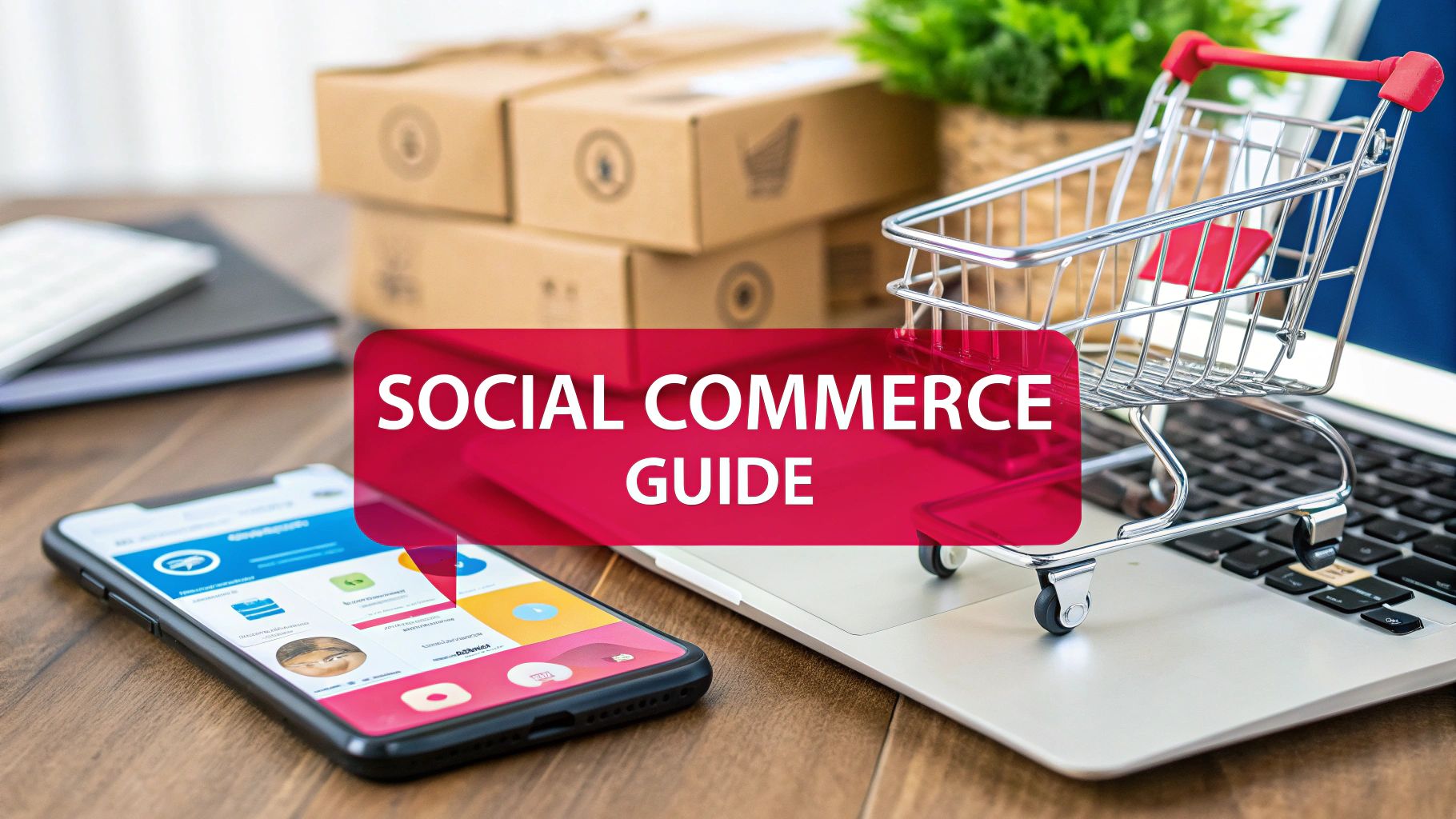Choosing the right social media channels is a critical decision for any ecommerce business. With dozens of options available, selecting where to invest your time and budget can feel overwhelming. A platform that drives massive sales for one brand might be a complete mismatch for another. The key is to align your chosen platform with your specific product, target audience, and business goals. This is where many businesses falter, spreading themselves too thin or investing in platforms that don't deliver a return.
This comprehensive guide is designed to solve that problem. We will provide a detailed breakdown of the best social media platforms for ecommerce, moving beyond generic descriptions to offer a strategic analysis of each. We'll explore everything from core features and audience demographics to advanced advertising capabilities and realistic budget considerations.
For each platform covered, including giants like Instagram and Facebook alongside specialised services like Xiaohongshu and WhatsApp Business, you will find:
- Honest Assessments: We look at both the strengths and limitations of each platform.
- Actionable Use Cases: Discover how to apply specific features to boost your sales.
- Practical Guidance: Get implementation tips to get you started quickly.
- Visual Aids: Screenshots are included to illustrate key features, along with direct links to each platform.
Our goal is to equip you with the insights needed to make an informed decision, helping you select the platforms that will generate tangible results for your ecommerce venture. Let’s dive in.
1. Facebook
With nearly three billion monthly active users, Facebook remains an undeniable powerhouse and one of the best social media platforms for ecommerce, especially for businesses targeting a broad demographic spectrum. Its sheer scale provides unparalleled reach, making it a foundational platform for almost any online retail strategy.
What sets Facebook apart is its deeply integrated ecosystem. Brands can create a seamless customer journey from discovery to purchase without the user ever leaving the platform. This is powered by features like Facebook Shops, which allow you to build a complete, native online storefront, and Marketplace, a C2C and B2C hub for direct listings. This integration extends to Messenger for customer service and Instagram for cross-platform campaigns, creating a unified marketing front.
Key Strengths & Implementation Tips
The platform’s primary advantage lies in its sophisticated advertising suite. You can leverage detailed targeting options based on demographics, interests, behaviours, and even custom audiences from your website traffic or email lists. This precision is crucial for maximising return on ad spend (ROAS).
For ecommerce brands, the key is to move beyond simple boosted posts. Utilise dynamic ads to automatically show relevant products to users who have previously visited your website. This retargeting strategy is highly effective for converting warm leads.
However, be aware of the significant competition and declining organic reach. A "pay-to-play" approach is now essential for consistent visibility. Budgeting for paid advertising is not optional but a requirement for growth on the platform.
- Best For: Brands with diverse target audiences, businesses investing in paid advertising, and retailers seeking an all-in-one shopping and marketing solution.
- Pricing: Free to create a business page and shop. Advertising costs are variable based on your budget and targeting.
- Website: https://www.facebook.com/
2. Instagram
Transitioning from a photo-sharing app to a full-fledged commercial hub, Instagram is a visual-first titan. With over two billion active users, it stands as one of the best social media platforms for ecommerce, particularly for brands in fashion, beauty, home decor, and food whose products benefit from strong aesthetic presentation. Its user base skews younger, offering a direct channel to Millennial and Gen Z consumers.
What truly sets Instagram apart is its ability to turn visual inspiration directly into a sale. This is achieved through a suite of integrated commerce tools, including Instagram Shopping, which allows brands to tag products directly in posts, Stories, and Reels. The dedicated Shop tab acts as a digital storefront, creating a frictionless path for users to discover and purchase products. This visual-driven discovery model is a powerful alternative to traditional search-based shopping. Learn more about optimising your social media marketing in the UAE to leverage these features effectively.
Key Strengths & Implementation Tips
The platform’s core strength lies in its high engagement rates and the power of visual storytelling. Features like Stories and Reels provide an authentic, behind-the-scenes way to connect with audiences, building community and trust far more effectively than static product shots. This is also the epicentre of influencer marketing, providing powerful third-party validation.
For ecommerce brands, the key is to blend commerce with content seamlessly. Don't just post product photos; use Reels to show your product in action, run polls in Stories to get customer feedback, and collaborate with creators who align with your brand values to build credibility.
However, the algorithm's constant evolution can impact organic reach, making consistency in posting high-quality visual content non-negotiable. Success demands a commitment to producing an ongoing stream of aesthetically pleasing photos and engaging videos.
- Best For: Visually-driven brands (e.g., apparel, cosmetics, home goods), businesses targeting younger demographics, and companies leveraging influencer marketing.
- Pricing: Free to create a business account and shop. Advertising costs are variable and managed through the Meta Ads Manager.
- Website: https://www.instagram.com/
3. TikTok
No longer just a platform for dance challenges, TikTok has rapidly evolved into a cultural and commercial phenomenon. It’s one of the best social media platforms for ecommerce if your target audience includes Gen Z and Millennials. Its algorithm-driven 'For You' page offers unparalleled potential for organic reach and virality, allowing even new brands to gain massive visibility overnight.
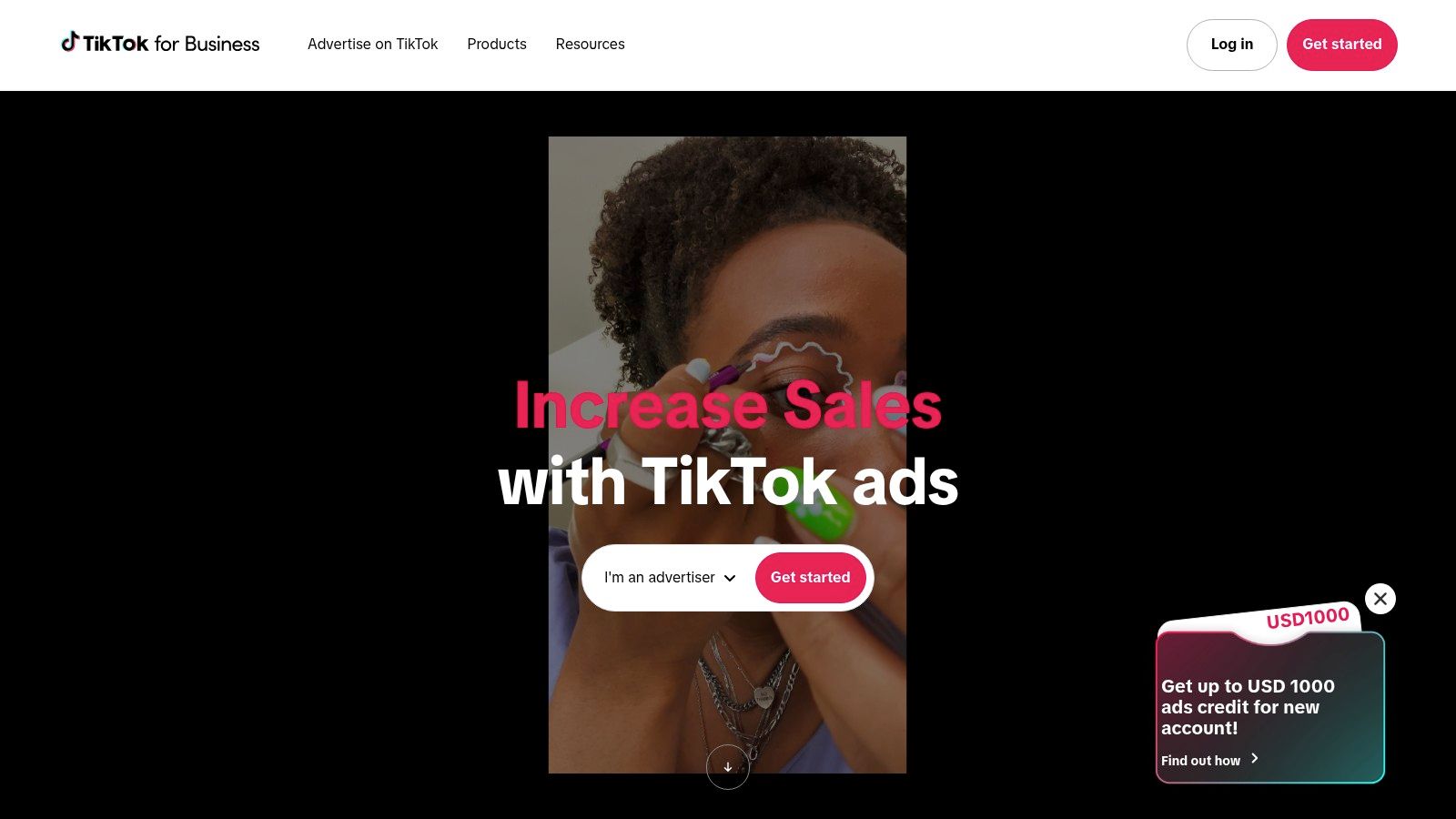
The platform thrives on authenticity and creativity. Unlike the polished aesthetic of Instagram, TikTok users reward raw, entertaining, and relatable content. Features like In-Feed Ads that blend seamlessly with user-generated videos and Branded Hashtag Challenges encourage mass participation, turning consumers into co-creators of your marketing campaign. For brands leveraging TikTok, learning how to collaborate on TikTok with influencers can unlock new avenues for audience reach and product promotion.
Key Strengths & Implementation Tips
The primary strength of TikTok is its unique ability to create trends and drive sales through "TikTok Made Me Buy It" virality. Success hinges on understanding the platform's fast-paced culture and creating content that feels native, not like a traditional advertisement. You can find many powerful social media content ideas to get started.
The key for ecommerce brands is to embrace short-form video that entertains, educates, or inspires. Showcase your products in real-world scenarios, create behind-the-scenes content, or participate in relevant trends to connect with users authentically.
Be mindful that content has a very short lifespan due to rapidly changing trends. This requires a commitment to consistent content creation and staying agile. While the viral potential is high, it isn't guaranteed, and a deep understanding of the platform's nuances is crucial for success.
- Best For: Brands targeting younger demographics (Gen Z, Millennials), businesses with visually appealing products, and marketers embracing creative, trend-driven video content.
- Pricing: Free to create a business account. TikTok for Business advertising costs are variable and based on campaign objectives and budget.
- Website: https://www.tiktok.com/business/en
4. Pinterest
Often described as a visual discovery engine rather than a traditional social network, Pinterest is a uniquely powerful platform for ecommerce. Users, or "Pinners," actively come to the site for inspiration and to discover products, creating an environment where brand content is welcomed rather than seen as intrusive. Its search-centric nature gives content an exceptionally long lifespan, driving traffic and sales for months or even years.
What makes Pinterest one of the best social media platforms for ecommerce is its direct link between inspiration and action. It’s built to guide users down the purchase funnel, from broad ideas to specific product choices. Features like Rich Pins automatically sync information like price and stock availability directly from your website, while Shopping Ads and catalog integrations allow you to turn your entire product line into shoppable Pins, targeting users with high commercial intent.
Key Strengths & Implementation Tips
The platform’s core advantage is the high purchase intent of its user base. Unlike other platforms where users are primarily connecting with friends, Pinners are actively planning purchases, from home decor and fashion to recipes and travel. This results in some of the highest referral traffic for ecommerce sites.
To succeed on Pinterest, think like a search engine optimiser, not just a social media manager. Use descriptive, keyword-rich titles and descriptions for your Pins and boards. High-quality, vertically-oriented imagery is non-negotiable as it performs best on the mobile-first interface.
A significant consideration is the platform's user demographic, which historically skews heavily female. While this is changing, it remains a crucial factor for targeting. Success demands a consistent strategy focused on providing aesthetic, inspirational, and helpful visual content rather than direct, hard-sell tactics.
- Best For: Brands in visual-heavy niches like fashion, home goods, food, and DIY; businesses targeting a predominantly female audience; retailers focused on driving long-term website traffic.
- Pricing: Free to create a business account and Pins. Advertising is based on a pay-per-click model with variable costs.
- Website: https://www.pinterest.com/
5. YouTube
As the world's second-largest search engine, YouTube has evolved far beyond a simple video-sharing site into one of the best social media platforms for ecommerce. Its power lies in using video to build deep connections, demonstrate product value, and guide customers through the consideration phase of their purchasing journey. For brands willing to invest in video, the potential for engagement and authority-building is immense.
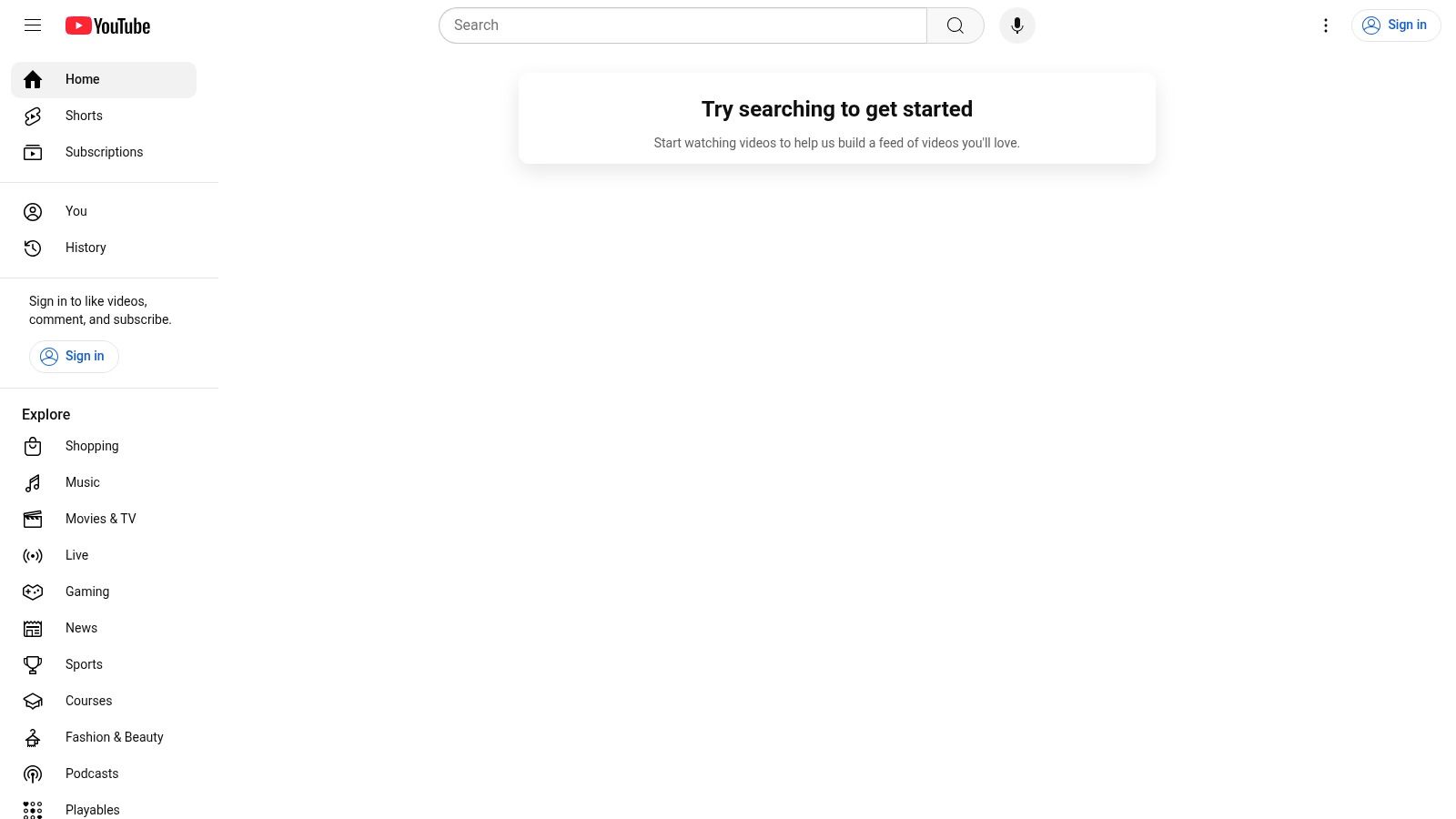
What makes YouTube unique for ecommerce is its search-centric nature and the longevity of its content. Unlike ephemeral posts on other feeds, a well-optimised product review or tutorial can attract targeted traffic for years. Features like YouTube Shopping allow creators to tag products directly in videos and live streams, while its seamless integration with the Google Ads ecosystem provides powerful retargeting and audience-building capabilities.
Key Strengths & Implementation Tips
The platform’s main advantage is the high engagement driven by long-form video, which allows for detailed storytelling and product demonstrations that are impossible on other platforms. You can leverage various ad formats, from skippable in-stream ads to non-skippable pre-roll clips, to capture attention at different stages of the funnel. The strong SEO synergy with Google means your video content can rank in both YouTube and standard Google search results.
For ecommerce brands, focus on creating value-driven content, not just advertisements. Develop how-to guides, unboxing videos, or customer testimonials that solve a problem or answer a question. This builds trust and positions your brand as an expert, making the eventual sale feel more natural.
However, be prepared for the significant upfront investment in time and equipment required for high-quality video production. Unlike other platforms, consistency is paramount on YouTube; sporadic posting will struggle to gain traction with the algorithm.
- Best For: Brands with products that benefit from visual demonstration, businesses targeting a specific niche or hobbyist audience, and retailers committed to a long-term content strategy.
- Pricing: Free to create a channel and upload videos. Advertising costs are variable based on your budget and campaign goals.
- Website: https://www.youtube.com/
6. Snapchat
Snapchat has carved out a unique space as one of the best social media platforms for ecommerce brands targeting Gen Z and younger millennials. Its focus on ephemeral, vertical video content and augmented reality creates a highly interactive and urgent environment. The platform’s core appeal lies in its raw, in-the-moment communication style, offering brands a way to connect with users on a more personal and less polished level.
What truly distinguishes Snapchat is its pioneering work in augmented reality marketing. Features like Sponsored Lenses and Filters allow users to virtually try on products, from makeup to sunglasses, creating an immersive and shareable brand experience. This is complemented by Snap Ads, which are full-screen vertical video ads, and the Discover section, where brands can place high-quality, editorial-style content alongside major publishers, capturing user attention in a premium context.
Key Strengths & Implementation Tips
The platform’s main strength is its unparalleled engagement with a younger demographic that is often harder to reach on other networks. The creative and playful nature of Snapchat’s ad formats encourages user participation rather than passive consumption, leading to higher brand recall and interaction rates.
For ecommerce retailers, the key is to leverage AR Lenses for virtual try-on experiences. This not only drives engagement but also helps bridge the gap between online browsing and in-store purchasing, potentially reducing return rates by giving consumers more confidence in their decision.
However, the platform's analytics are not as deep as those offered by Meta or Google, and the ephemeral nature of content means a constant creative refresh is necessary to stay relevant. Success on Snapchat requires a commitment to producing frequent, native-style content that feels authentic to the platform's fast-paced, visual language.
- Best For: Fashion, beauty, and lifestyle brands targeting users under 30; companies able to invest in creative, AR-driven campaigns.
- Pricing: Free to create an account. Advertising costs are variable and depend on your budget, campaign goals, and targeting selections.
- Website: https://www.snapchat.com/
7. Twitter
Now known as X, Twitter thrives on immediacy and public conversation, carving out a unique niche among the best social media platforms for ecommerce. While not a traditional visual marketplace, its strength lies in real-time brand communication, rapid-fire customer service, and the ability to tap directly into trending cultural moments and news cycles.
The platform excels at building brand personality and fostering community through direct, unfiltered interaction. Ecommerce brands can leverage this conversational nature to handle customer queries publicly, run flash sales tied to live events, and gather instant feedback on products. Features like Promoted Tweets boost visibility beyond your followers, while Twitter Cards allow you to attach rich photos, videos, and website previews to your posts, making them more engaging and clickable than a simple text tweet.
Key Strengths & Implementation Tips
Twitter’s primary advantage is its role as a real-time pulse of public opinion and a direct line to your customers. It is an unparalleled tool for brand monitoring and reactive marketing. Hashtag campaigns can galvanise your audience around a launch or a cause, creating user-generated content and organic buzz.
For ecommerce success, focus on speed and personality. Use Twitter as your primary customer service channel for quick resolutions. Monitor brand mentions and relevant keywords to engage in conversations organically, positioning your brand as helpful and "in the know."
However, be mindful of the platform's fast-paced nature. The short lifespan of a tweet means a high volume of content is often necessary to stay visible, and the strict character limit demands concise, impactful messaging. It is less suited for deep, narrative-driven brand storytelling compared to other platforms.
- Best For: Brands with a strong voice, businesses focused on community engagement and rapid customer service, and retailers who can react quickly to trends.
- Pricing: Free to create and manage an account. Advertising costs are variable and depend on your campaign objectives and budget.
- Website: https://twitter.com/
8. LinkedIn
While often viewed as a professional networking and job-seeking site, LinkedIn has carved out a crucial niche as one of the best social media platforms for ecommerce, specifically for Business-to-Business (B2B) brands. Its entire ecosystem is built around professional identity, industry, and corporate hierarchy, providing unparalleled access to decision-makers and high-value clients.
What distinguishes LinkedIn is its context-driven environment. Users are in a business mindset, making them more receptive to industry-specific solutions, corporate services, and high-ticket items. Features like Company Pages allow you to build a corporate presence, while Sponsored Content and Sponsored Messaging (InMail) enable direct, highly targeted outreach to professionals based on their job title, industry, company size, and seniority. This precision is invaluable for B2B lead generation and nurturing.
Key Strengths & Implementation Tips
The platform’s core strength is its ability to facilitate relationship-building and establish brand authority. By sharing insightful articles, case studies, and industry news, B2B ecommerce companies can position themselves as thought leaders, building the trust required for long-term, high-value sales cycles.
For ecommerce brands in the B2B space, the goal is to educate, not just sell. Use content to solve your target audience's professional pain points. A well-written article demonstrating your product's value in a real-world business scenario is far more effective than a direct sales pitch.
However, be prepared for significantly higher advertising costs compared to B2C-focused platforms. The cost per click is higher, but so is the potential lifetime value of a converted lead. The platform is less effective for most direct-to-consumer product sales.
- Best For: B2B ecommerce, high-ticket items, wholesale businesses, and brands focused on building professional authority and generating qualified leads.
- Pricing: Free to create a Company Page. Advertising costs are variable and generally higher than other social platforms.
- Website: https://www.linkedin.com/
9. WhatsApp Business
While often viewed as a messaging app, WhatsApp Business has evolved into a formidable conversational commerce tool, making it one of the most direct social media platforms for ecommerce. It leverages its massive user base to create an intimate, one-to-one sales and support channel, shifting marketing from a broadcast model to a personal dialogue. This direct line to the customer is invaluable for building trust and loyalty.
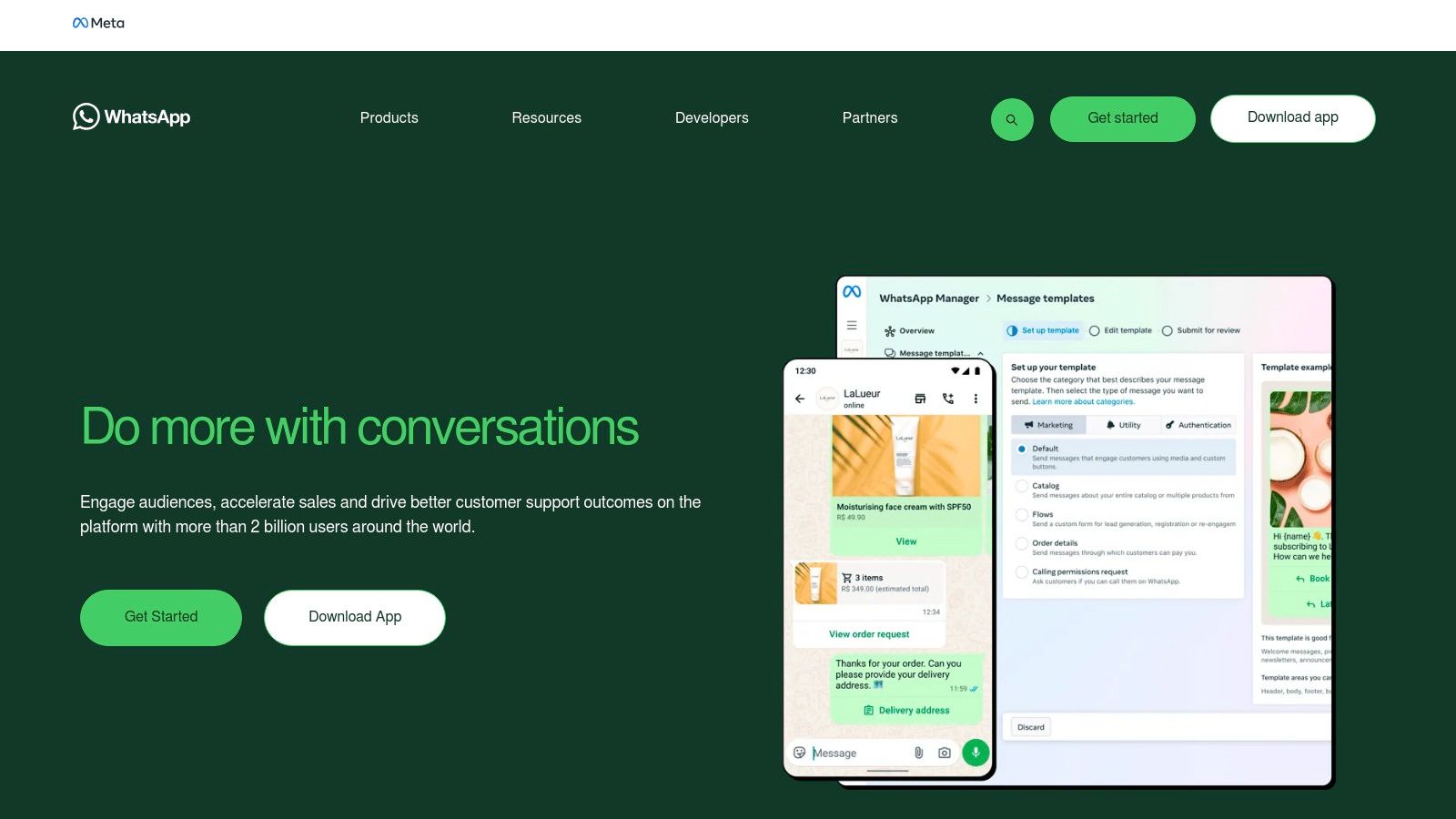
What makes WhatsApp Business unique is its ability to integrate sales directly into customer conversations. Features like Product Catalogs allow brands to showcase their offerings within the chat, enabling users to browse and inquire about items without leaving the app. This creates a low-friction path to purchase, ideal for personalised recommendations, answering product queries, and closing sales in real-time.
Key Strengths & Implementation Tips
The platform's primary strength lies in its exceptionally high engagement rates. Unlike email or social media feeds, WhatsApp messages have open rates often exceeding 90%, ensuring your communications are seen. This is perfect for order confirmations, shipping updates, and post-purchase support, significantly enhancing the customer experience. For a deeper dive, you can explore some advanced WhatsApp marketing tips.
For ecommerce brands, the key is to use automation thoughtfully. Set up automated greeting messages for new inquiries and away messages for after-hours support, but ensure a human is available to handle complex queries. This balances efficiency with the personal touch customers expect.
The main limitation is its reliance on the customer initiating contact or opting in, as unsolicited marketing is heavily restricted. Success on the platform depends on driving traffic from other channels (like your website or Instagram ads with a "Click to WhatsApp" call-to-action) to start conversations.
- Best For: Brands focused on high-touch customer service, businesses in markets with high WhatsApp penetration, and retailers selling considered-purchase items.
- Pricing: The WhatsApp Business app is free. The WhatsApp Business Platform (API) has conversation-based pricing.
- Website: https://www.whatsapp.com/business
10. WeChat
For businesses aiming to penetrate the massive Chinese market, WeChat is not just an option; it is an absolute necessity. Far more than a messaging app, WeChat is an all-encompassing "super app" that integrates social media, payments, and commerce into a single, seamless ecosystem. This makes it one of the best social media platforms for ecommerce within this specific, yet colossal, demographic.
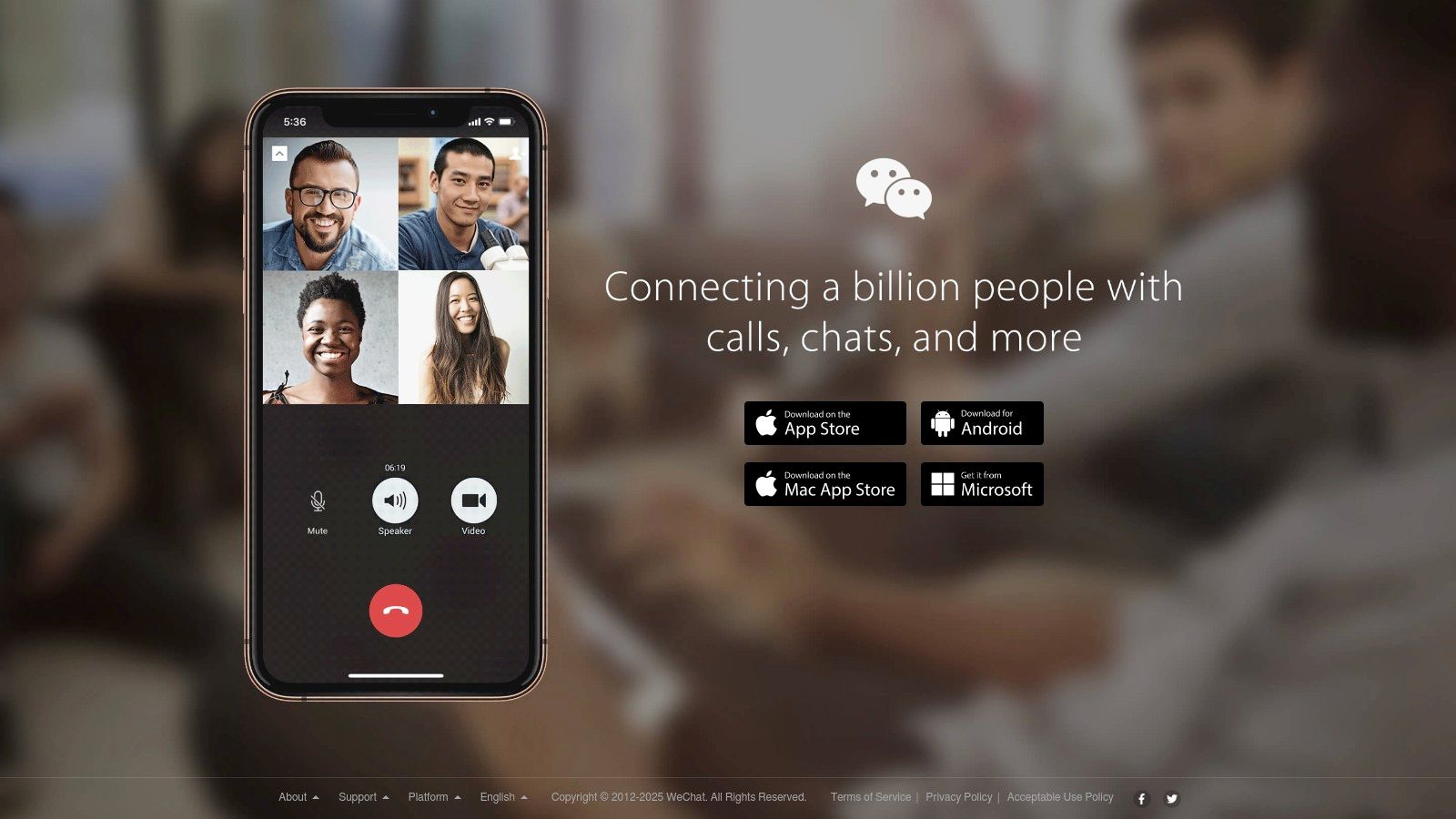
The platform's power lies in its ability to contain the entire customer journey. Users discover products through official brand accounts, explore them within WeChat Stores or lightweight Mini Programs (apps within the app), and complete purchases instantly using the integrated WeChat Pay. This frictionless process significantly reduces cart abandonment and creates unparalleled brand loyalty.
Key Strengths & Implementation Tips
WeChat’s primary advantage is its complete commercial integration. Mini Programs, in particular, allow brands to offer rich, app-like experiences, from interactive catalogues to loyalty programmes and customer service bots, without requiring users to download anything new. This creates a deeply engaging and convenient shopping environment that is difficult to replicate on any other platform.
The most effective strategy for ecommerce brands is to view WeChat as a complete digital headquarters, not just a marketing channel. Focus on building a community through your official account and driving them to a well-designed Mini Program for a superior commerce experience.
However, its immense strength in China is also its main limitation. The platform has minimal traction outside of the country, making it irrelevant for brands not targeting this region. The interface can also be complex for non-native marketers to navigate.
- Best For: Brands targeting the Chinese consumer market, businesses looking for a truly integrated commerce and payment solution, and companies investing in a long-term China strategy.
- Pricing: Free to create an official account. Development of Mini Programs and advertising costs are variable.
- Website: https://www.wechat.com/en/
11. Xiaohongshu (Little Red Book)
For brands aiming to penetrate the lucrative Chinese market, Xiaohongshu, or "Little Red Book", is one of the best social media platforms for ecommerce. It masterfully blends social media, content discovery, and e-commerce into a single, highly influential ecosystem. It functions as a trusted source for lifestyle trends, product reviews, and shopping inspiration, primarily targeting affluent, urban millennial and Gen Z women.
What makes Xiaohongshu unique is its foundation of trust built on authentic, user-generated content (UGC). Users post detailed reviews, tutorials, and lifestyle notes called "Biji", often featuring high-quality images and videos. This peer-to-peer recommendation model creates a powerful, community-driven sales funnel where discovery is organic and purchase intent is exceptionally high. The platform seamlessly integrates shopping, allowing users to buy featured products directly.
Key Strengths & Implementation Tips
The platform's core advantage is its ability to build brand reputation and drive sales through genuine user advocacy and influencer collaborations. Unlike traditional advertising, marketing on Xiaohongshu feels like a trusted recommendation from a friend. Success requires partnering with Key Opinion Leaders (KOLs) and Key Opinion Consumers (KOCs) who resonate with your brand ethos.
For international ecommerce brands, the key is to cultivate authenticity. Instead of hard-selling, focus on creating high-quality, visually appealing content that provides value and showcases how your product fits into the aspirational lifestyle of the Xiaohongshu user.
However, navigating the platform requires a deep understanding of Chinese consumer behaviour and content trends. The audience is sophisticated and quick to dismiss inauthentic or overly promotional content. A localised strategy is not just recommended; it is essential for success.
- Best For: Luxury, beauty, fashion, and lifestyle brands targeting the mainland Chinese market; businesses focusing on influencer and UGC-driven marketing.
- Pricing: Free to create an account. Operating an official brand account and running advertising campaigns requires a business licence and significant investment.
- Website: https://www.xiaohongshu.com/
12. Meesho
While not a traditional social media network, Meesho represents a powerful evolution in social commerce, making it a unique and valuable platform for ecommerce, particularly within the Indian market. It operates on a reseller model, empowering individuals and small businesses to sell products to their network via social channels like WhatsApp, Facebook, and Instagram without holding any inventory. This model transforms social interactions directly into sales opportunities.
What makes Meesho distinct is its complete ecosystem designed for social selling. It provides aspiring entrepreneurs with a vast catalogue of products from verified suppliers, handles all logistics from shipping to payments, and fosters a community for training and support. For ecommerce brands, it's less about creating a brand page and more about leveraging a massive, motivated, and decentralised sales force. This approach taps into the trust inherent in personal relationships, a powerful driver in many markets.
Key Strengths & Implementation Tips
The platform’s core strength is its low-barrier-to-entry framework. It democratises ecommerce by removing the need for upfront capital investment in stock, website development, or complex marketing tools. The built-in logistics and payment gateway infrastructure further simplifies the process, allowing sellers to focus purely on marketing and sales within their social circles.
For an existing ecommerce brand, the strategic advantage is not to sell on Meesho, but to become a supplier for Meesho. This provides access to millions of resellers who can market your products to a diverse and extensive customer base across India, multiplying your reach exponentially.
However, the platform is geographically limited to India, and for resellers, profit margins can be thin due to intense competition. Success depends heavily on the reseller's ability to build and maintain a strong personal network.
- Best For: Individuals looking to start an online business with zero investment, and Indian D2C brands wanting to expand their distribution channels through a reseller network.
- Pricing: Free for resellers to join and start selling. Suppliers have a different commission-based structure.
- Website: https://www.meesho.com/
Top 12 Social Media Platforms for Ecommerce Comparison
| Platform | Core Features ✨ | User Experience ★★★★☆ | Value Proposition 💰 | Target Audience 👥 | Unique Selling Points 🏆 | Price Points 💰 |
|---|---|---|---|---|---|---|
| Shops, Marketplace, Advanced Ads, Cross-platform integration | Robust analytics, broad demographic reach | Extensive user base, data-driven targeting | Businesses, e-commerce | Largest user base, integrated shopping & messaging | Moderate-high, pay-to-play ads | |
| Shopping tags, Reels, Stories, Influencer support | High engagement, visual-first interface | Strong visual branding & influencer marketing | Youth, lifestyle brands | Visually-driven, tight Facebook integration | Moderate, requires quality content | |
| TikTok | Short video ads, Hashtag challenges, Viral algorithm | Creative freedom, viral content potential | High organic reach, trend-driven marketing | Gen Z, Millennials | Viral marketing, trend culture mastery | Variable, ad-based |
| Rich Pins, Shopping Ads, Catalog uploads | Long content lifespan, discovery-driven | High purchase intent, referral traffic | Shoppers, DIY, lifestyle | Visual discovery engine with strong e-commerce focus | Moderate, CPC/CPM ads | |
| YouTube | Ad formats, Tutorials, Live streaming | High engagement on long content, SEO integration | Video marketing power, monetization options | All demographics | 2nd largest search engine, video-centric marketing | Moderate-high, ads based |
| Snapchat | Full-screen Snap Ads, AR Lenses, Ephemeral content | High engagement, immersive AR experiences | Youth engagement, innovative ad formats | Younger audiences | AR features, ephemeral messaging causing urgency | Moderate, ad based |
| Promoted Tweets, Multimedia Cards, Hashtag campaigns | Real-time engagement, fast-paced | Immediate feedback, effective customer service | Brands, news, real-time events | Real-time marketing, trending topic access | Moderate, pay-to-play ads | |
| Sponsored content, InMail, Company pages | Professional networking, B2B focused | Lead generation, brand authority | B2B professionals | Access to decision makers, professional targeting | High, premium ad pricing | |
| WhatsApp Business | Business profiles, Automated messaging, Product catalogs | High open rates, personalized communication | Secure, direct customer interactions | SMEs, customer service | Encrypted messages, high message response | Low to moderate |
| E-commerce stores, Mini Programs, WeChat Pay | All-in-one, seamless transactions | Integrated social, payment, commerce ecosystem | Chinese market, enterprises | Ecosystem combining chat, payments & commerce | Variable, platform fees | |
| Xiaohongshu | User reviews, Influencer marketing, E-commerce links | Highly engaged, trust-based community | Peer trust, niche luxury/goods focus | Chinese-speaking luxury buyers | Trusted UGC, influencer-driven, niche market | Not publicly disclosed |
| Meesho | Reseller model, Supplier access, Logistics support | Entrepreneur-friendly, community resources | Low-entry barrier for online business startups | Indian resellers & entrepreneurs | Reseller without inventory, strong training support | Free to start, fees on sales |
Final Thoughts
Navigating the expansive and ever-shifting world of social commerce can feel overwhelming. Throughout this guide, we have explored a diverse array of the best social media platforms for ecommerce, from global giants like Facebook and Instagram to powerful regional players such as WeChat and Meesho. Each platform offers a unique ecosystem, a distinct user demographic, and a specialised set of tools designed to transform casual browsers into loyal customers.
The core takeaway is this: there is no single "best" platform. The ideal choice is entirely dependent on your brand's specific context. A high-end fashion brand might find its home amidst the visual storytelling of Instagram and the aspirational boards of Pinterest. A B2B tech company will likely realise greater value from the professional network on LinkedIn. Meanwhile, a brand targeting Gen Z with fun, affordable products will see explosive growth potential on TikTok.
How to Choose Your Winning Platform
Making the right decision requires a strategic, internal audit before you commit resources. Your selection process should be a careful balancing act, weighing your business objectives against the inherent strengths and weaknesses of each platform we've analysed.
To guide your decision, consider these critical factors:
- Audience Alignment: Where does your target customer spend their time online? Go beyond simple demographics like age and gender. Consider their interests, online behaviours, and the type of content they actively engage with. A deep understanding of your ideal customer profile is non-negotiable.
- Product & Brand Suitability: Is your product highly visual? Does it require detailed demonstrations or benefit from user-generated content? The nature of what you sell dictates the most effective format. Highly aesthetic products thrive on Instagram and Pinterest, while products that solve complex problems are well-suited for long-form video on YouTube.
- Resource Allocation: Be realistic about your team's capacity. Do you have the skills and budget for high-production video, or are you better equipped for creating stunning static images and compelling copy? Each platform demands a different level of creative and financial investment. Starting small and mastering one or two channels is a far more effective strategy than spreading yourself too thin across five.
- Business Goals: What is your primary objective? Are you focused on brand awareness, lead generation, direct sales, or building a community? Align your platform choice with your key performance indicators. For direct conversions, platforms with robust, integrated shopping features like Facebook Shops or TikTok Shop are essential. For community building, a dedicated Facebook Group or engaging with followers on Twitter might be more appropriate.
Staying Ahead of the Curve
Ultimately, the journey to finding the best social media platforms for ecommerce is one of continuous experimentation, analysis, and adaptation. What works today might be less effective tomorrow. The digital landscape is in constant flux, shaped by new technologies, evolving algorithms, and shifting consumer behaviours.
Therefore, staying informed is not just an advantage; it's a necessity for survival and growth. As you refine your strategy, keeping an eye on emerging social media marketing trends is essential. Understanding concepts like the rise of AI-driven personalisation, the dominance of short-form video, and the growing importance of authenticity will allow you to pivot your strategy proactively and maintain a competitive edge. The most successful ecommerce brands are those that remain agile, listen to their audience, and are unafraid to test new frontiers in the dynamic world of social commerce.
Feeling overwhelmed by the options and need a strategic partner to navigate the complexities of social commerce? Let the experts at Grassroots Creative Agency build a tailored social media strategy that drives real results for your ecommerce business. Contact us today to see how our data-driven approach can elevate your brand and boost your sales.

